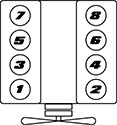What is the story of the GM 6.5 - why is it blowing PMD's ??. Short answer is the Lift Pump
The 6.5L Detroit (GM) diesel was an evolution of the earlier 6.2L it is an electronically controlled mechanically injected engine. That is it still has mechanical injectors. GM began rolling out the 6.5 for the 1992 model year, and it altogether replaced the 6.2 following the 1993 model year. Unlike the earlier engine, the 6.5L was available in both factory turbocharged and naturally aspirated versions, with the turbocharged version offering a healthy increase in performance.
Like the 6.2L, the 6.5L diesel was available in 1/2 through 1 ton pickup models until its retirement following the 2002 model year. However, the engine platform was not retired entirely - Humvee manufacturer AM General continued the 6.5 diesel's legacy under license from General Motors. Unlike the 6.2L, the 6.5L was produced in both naturally aspirated and turbocharger versions, the latter providing significantly more torque.
[ You can opt out of Google Ads if you are a registered user at /ad-options ]6.5L GM/DETROIT DIESEL SPECS
| Engine: | GM/Detroit 6.5L diesel | |
| Production Years: | 1992 to current. Retired from the GMC/Chevrolet pickup line after the 2000 MY, used in Sierra/Silverado C3500HD chassis cab through 2002 MY. | |
| Displacement: | 6.5 liters, 395 cubic inches | |
| Firing Order: | 1-8-7-2-6-5-4-3 |
|
| Engine Block: | Cast iron | |
| Cylinder Heads: | Cast iron | |
| Compression Ratio: | 18.1 : 1 to 21.5 : 1 (varied with application, turbocharged vs. naturally aspirated) | |
| Bore: | 4.06" | |
| Stroke: | 3.82" | |
| Aspiration: | Turbocharged and naturally aspirated versions produced | |
| Injection: | Indirect injection, Stanadyne DS4 injection pump | |
| Valvetrain: | Common overhead valve (OHV), 2 valves per cylinder | |
| Oil Capacity: | 7 qts w/ filter for 1992 - 1998 model years, 8 qts w/ filter for 1999+ model years. Always check oil level after filling crankcase. | |
| Engine Weight: | ~ 750 lbs | |
| Max Engine Speed: | 3,400 rpm | |
| Peak Horsepower: | Introduced at 180 hp @ 3,400 rpm. Offered as high as 215 hp @ 3,200 rpm. | |
| Peak Torque: | Introduced at 360 lb-ft @ 1,700 rpm. Offered as high as 440 lb-ft @ 1,800 rpm. | |
Many variations of GM's 6.5L diesel were produced, including a special 120 horsepower (260 lb-ft) model specifically for delivery trucks. The most powerful version of the engine used in GMC/Chevrolet trucks was a 215 hp, 440 lb-ft, turbocharged model. For Silverado and Sierra pickups, the engine was backed by either a 4L80E 4 speed automatic transmission (with overdrive) or the popular NV4500 5 speed manual transmission. Common problems with the 6.5 diesel include crankshaft, glow plug, and PMD failure. Overheating is also an issue with the 6.5L, and it can lead to cylinder head cracking. In essence, the 6.5L Detroit diesel was a leap above the 6.2L, but it's generally accepted that the engine was outpaced by Ford's Power Stroke and Dodge's Cummins turbodiesel offerings.
6.5L PUMP MOUNTED DRIVER (PMD/FSD)
For the turbocharged 6.5L GM diesel, its Achilles heel is the pump mounted driver. The pump mounted driver (PMD), or alternatively the fuel solenoid driver (FDS, this is typically what Stanadyne refers to it as) is a small module mounted to the driver side of the injection pump. Its purpose is to supply power to the fuel solenoid, which allows or blocks fuel flow to the injection pump. When power is supplied to the fuel solenoid, fuel flows to the injection pump and the engine is allowed to run. When power is cut from the fuel solenoid, fuel flow abruptly stops and the engine will stall. If Lift Pump pressure to the inlet is below what the engine NEEDS - and that MUST be above 5 psi at all times at idle or Wide Open Throttle - (WOT) this power to the fuel solenoid which is in effect its "throttle" mechanism - overheats the power transistors - which are acting as switching transistors to perform Pulse Width Modulation (PWM) on the fuel solenoid on the PMD and eventually they "blow" or "open" in electronic terms and then there is no more throttle and the engine will not start or run. If there is sufficient fuel pressure to the IP - the IP simply balances the fuel injection and the engine "idles", without any need to pull on the throttle plate, and the power needed to increase RPM is lock step in lower amounts needed to accelerate the engine.
The problem with the PMD is quite simple; it produces a tremendous amount of heat when loaded loike that in a high duty cycle. If not - it is cool. While diesel fuel flow into through the injection pump is designed to keep the PMD cool, it also neglects to protect the module once an engine is shut down, fuel flow ceases, and a heat soak effect causes the PMD to reach temperatures that the unit is not ideally designed to take. The location of the PMD, the heat it produces, and the lack of heat dissipation also play roles in the life of the PMD. When a PMD becomes faulty or overheats, it may cause the engine to loose power and/or stall, but the REAL culprit is the Lift Pump failing to provide enough i let pressure to the IP which is what is over heating the PMD actually. .
Additional symptoms of a failing PMD include:
• Engine rapidly loses and regains power (can feel similar to a misfire in some instances)
• Engine randomly stalls (stalling is arguable the number 1 sign of a bad PMD)
• Engine will not restart when hot - once cooled, the engine typically restarts normally
• Engine idles rough or experiences poor idle quality
• Engine hard start, no start condition
These symptoms above are actually ALSO caused by fuel pressure starvation and hence the IP cannot provide the proper pressures to pop the injectors with the amount of fuel volume behind them to accelerate the engine. GM from 94 to 98 specified a 7 to 9 psi solenoid pump and then in 99 to 2002 specified a 10 to 12 psi pump. Neither solenoid pump produced those figure reliably for long or at higher rpms because they could not produce the needed flow of gallons per hours
The symptoms may be experienced to varying degrees, but often only occur when the engine has reached operating temperature. At this point, the injection pump is hot, and the PMD suffers severely in with its poor ability to dissipate heat combined with the NEED to try to hold the throttle plate open because they fuel needed is just not there. . Part of a solution to PMD related problems is an aftermarket PMD relocation kit and heat sink.
Since the the Pump Mounted Driver (PMD) or Fuel System Driver (FSD) is an electronic module used to amplify electrical signals from the engine PCM to the fuel control solenoid. Without the PMD, there is no way to actuate the fuel solenoid and the engine will not run. FSD failures are somewhat common and the symptoms include stalling, no start condition, no start condition only when hot, and excessive cranking/hard start condition. The driver (and its location) is without a doubt one of the 6.5L GM diesels shortcomings. /there are many solutions for relocating the PMD to a more appropriate location and taking additional steps, such as adding a heat sink, to increase the unit's reliability, but the real issue is the lift pump pressure - and you will notice with adequate fuel inlet pressure to the IP - the PMD really does not get much above "warm" at all. You should be able to put your hands on the heat sink and n ot get burned or feel it so hot you have to let go. Search this site for " 6.5 " to find lots of articles to assist and example further




